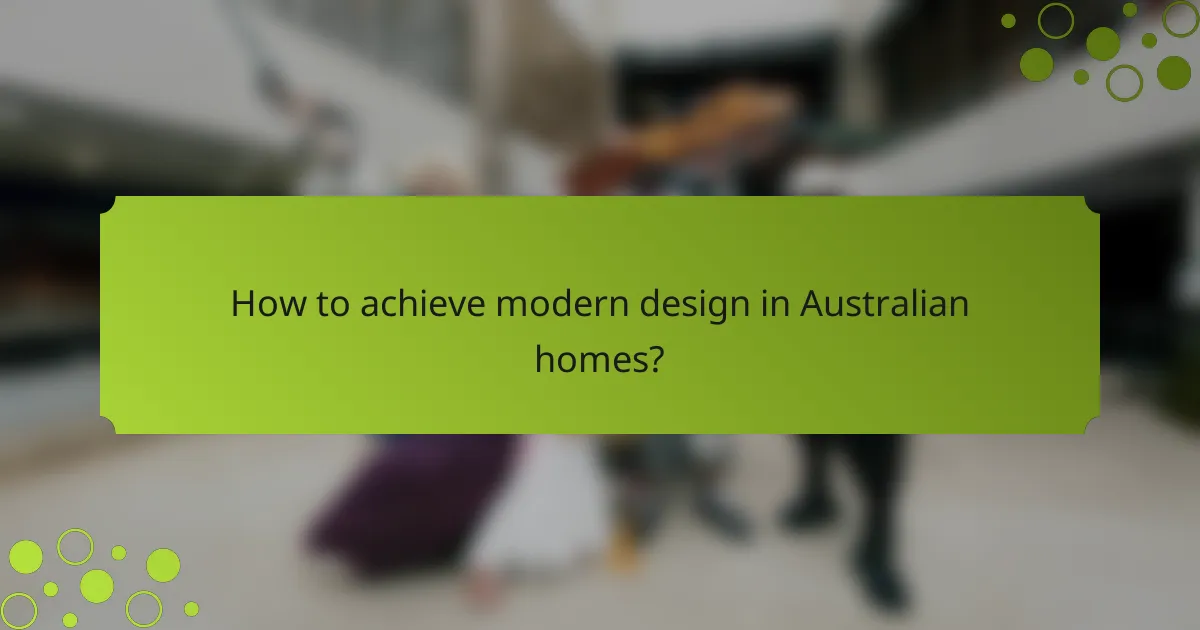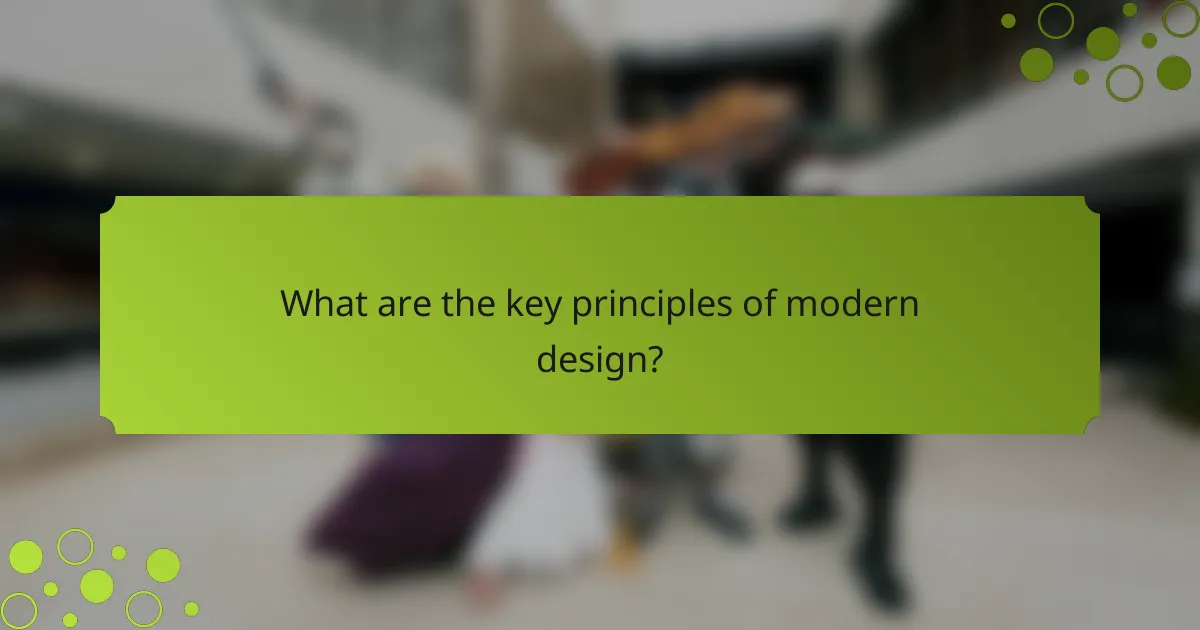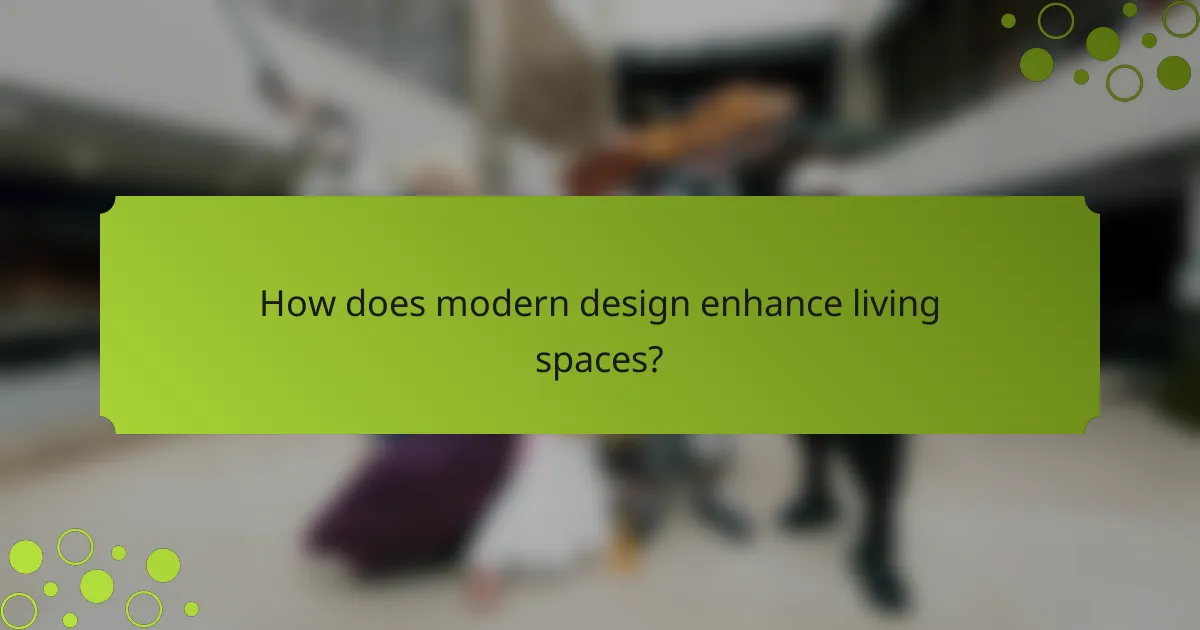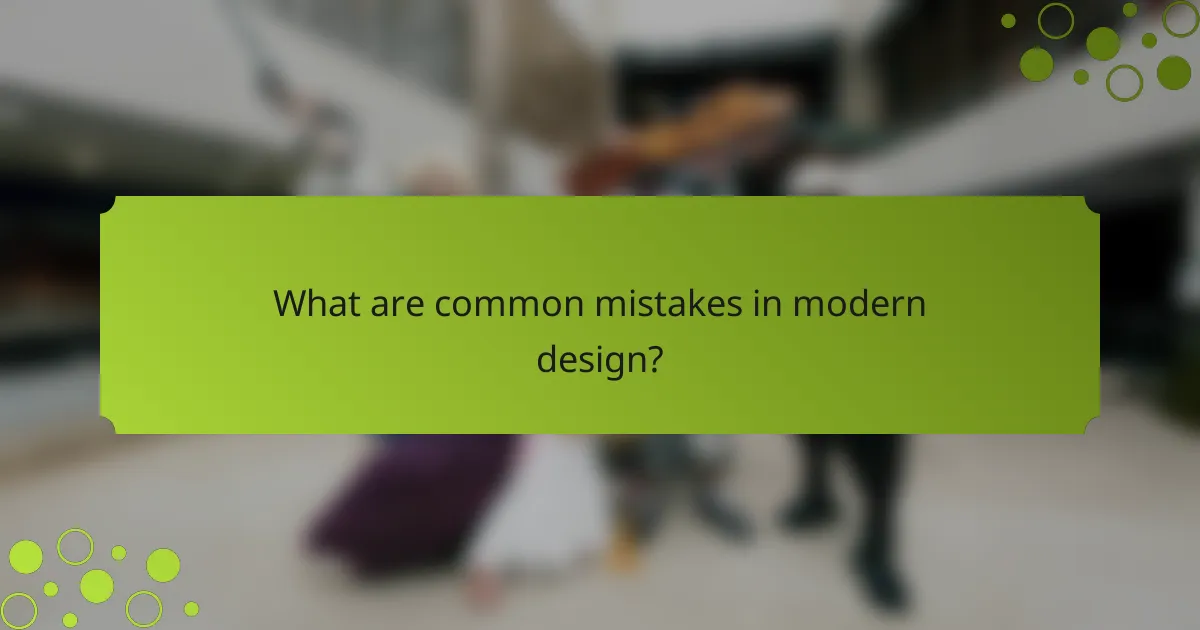Modern design is characterized by clean lines, functional spaces, and minimal ornamentation, creating serene and uncluttered environments. This style prioritizes simplicity and practicality, ensuring that each element serves a purpose while contributing to an aesthetically pleasing atmosphere. The choice of materials, such as glass, steel, and wood, plays a crucial role in enhancing both the aesthetic and functionality of modern spaces.

How to achieve modern design in Australian homes?
To achieve modern design in Australian homes, focus on clean lines, functional spaces, and minimal ornamentation. This approach emphasizes simplicity and practicality while creating a serene and uncluttered environment.
Incorporate clean lines
Clean lines are essential in modern design, providing a sense of order and simplicity. Use straight edges and geometric shapes in furniture and architectural elements to enhance this aesthetic.
Consider furniture pieces with sleek profiles and minimal detailing. For example, a low-profile sofa with straight arms and a simple coffee table can create a cohesive look that embodies modern design.
Utilize functional spaces
Functional spaces prioritize usability and efficiency, making the most of available square footage. Open floor plans are popular in modern Australian homes, allowing for seamless transitions between living areas.
Incorporate multi-functional furniture, such as a dining table that doubles as a workspace. This flexibility can help maximize space while maintaining a clean and organized appearance.
Minimize ornamentation
Modern design favors minimal ornamentation, focusing instead on the beauty of materials and forms. Avoid excessive decorations and choose a few statement pieces to create visual interest without clutter.
For instance, a large piece of artwork or a sculptural light fixture can serve as a focal point while keeping the overall design uncluttered. Aim for simplicity in accessories and decor to maintain a modern feel.
Choose neutral color palettes
A neutral color palette is a hallmark of modern design, promoting a calm and cohesive atmosphere. Shades of white, gray, beige, and earth tones work well together and can be accented with bolder colors in small doses.
When selecting paint or furnishings, consider using soft, muted tones that complement natural light. This approach helps create a spacious feel, which is particularly beneficial in smaller Australian homes.
Integrate natural materials
Integrating natural materials enhances the modern design aesthetic while promoting sustainability. Use wood, stone, and metal to add warmth and texture to your spaces.
For example, hardwood flooring paired with stone countertops can create a harmonious balance. Look for sustainably sourced materials to align with eco-friendly practices, which are increasingly valued in contemporary Australian design.

What are the key principles of modern design?
The key principles of modern design include simplicity, functionality, and open spaces. These elements work together to create environments that are aesthetically pleasing while serving practical purposes.
Simplicity and minimalism
Simplicity and minimalism are foundational to modern design, emphasizing clean lines and a clutter-free aesthetic. This approach often involves using a limited color palette and reducing decorative elements to focus on essential forms.
To achieve simplicity, consider choosing furniture and decor that serve multiple purposes. For example, a sleek coffee table can double as storage, minimizing visual clutter while maximizing utility.
Functionality over form
In modern design, functionality takes precedence over mere appearance. This principle encourages the creation of spaces that prioritize usability, ensuring that every element serves a clear purpose.
When designing a room, assess how each piece will be used. For instance, opt for ergonomic furniture that enhances comfort and efficiency, rather than items that are only visually appealing.
Open floor plans
Open floor plans are a hallmark of modern design, promoting a sense of spaciousness and fluidity between different areas of a home or office. This layout fosters interaction and can make smaller spaces feel larger.
When considering an open floor plan, think about how to delineate spaces without physical barriers. Use area rugs, furniture arrangements, or lighting to define different zones while maintaining an airy feel.

Which materials are best for modern design?
Modern design emphasizes clean lines and functional spaces, making the choice of materials crucial. The best materials for this style include glass, steel, and wood, each contributing unique characteristics that enhance the overall aesthetic and functionality.
Glass for transparency
Glass is a staple in modern design due to its ability to create a sense of openness and transparency. It allows natural light to flood spaces, making them feel larger and more inviting.
When using glass, consider its thickness and treatment. Tempered or laminated glass offers safety and durability, while low-emissivity (Low-E) glass can improve energy efficiency by reflecting heat. Large glass panels or windows can serve as focal points in a room.
Steel for structural integrity
Steel is favored in modern design for its strength and versatility. It provides structural integrity, allowing for open floor plans and expansive spaces without the need for excessive support beams.
Incorporating steel elements, such as beams, columns, or furniture, can create a sleek, industrial look. Ensure that the steel is treated to prevent rust, especially in humid environments, and consider using powder-coated finishes for added aesthetic appeal.
Wood for warmth
Wood adds warmth and texture to modern design, balancing the coolness of glass and steel. It can be used in flooring, cabinetry, or accent pieces to create a cozy atmosphere.
Choose sustainably sourced wood to align with eco-friendly practices. Options like oak, walnut, or bamboo are popular for their durability and aesthetic qualities. Mixing different wood finishes can create visual interest while maintaining a cohesive design.

How does modern design enhance living spaces?
Modern design enhances living spaces by emphasizing clean lines, functional layouts, and minimal ornamentation. This approach creates environments that are not only aesthetically pleasing but also practical and efficient for daily living.
Improves natural light
Modern design often incorporates large windows and open spaces, maximizing the flow of natural light. This not only brightens interiors but also reduces the need for artificial lighting, leading to energy savings.
Consider using light-colored walls and reflective surfaces to further enhance brightness. Avoid heavy drapes; instead, opt for sheer curtains that allow light to filter through while maintaining privacy.
Encourages efficient layouts
Efficient layouts are a hallmark of modern design, focusing on functionality and accessibility. Open floor plans are common, allowing for seamless transitions between spaces and promoting social interaction.
When designing a space, prioritize furniture that serves multiple purposes, such as storage ottomans or foldable tables. This approach maximizes usable space and minimizes clutter, creating a more organized environment.
Promotes a calming environment
Modern design promotes a calming environment by using a neutral color palette and minimalistic decor. This simplicity helps reduce visual noise, making spaces feel more tranquil and inviting.
Incorporate natural materials like wood and stone to enhance the soothing atmosphere. Additionally, consider adding plants to bring a touch of nature indoors, which can further contribute to a peaceful ambiance.

What are common mistakes in modern design?
Common mistakes in modern design often stem from a lack of understanding of clean lines, functional spaces, and minimal ornamentation. Designers may overlook the importance of balance, proportion, and the harmony of materials, leading to cluttered or impractical spaces.
Ignoring Functionality
One major mistake is prioritizing aesthetics over functionality. While a space may look visually appealing, it should also serve its intended purpose effectively. For example, a beautifully designed kitchen that lacks adequate storage or workspace can hinder daily cooking tasks.
To avoid this pitfall, consider the primary activities that will occur in the space. Ensure that furniture and layout facilitate these activities rather than obstruct them. A practical approach is to create zones within a room that cater to specific functions.
Overcomplicating Design Elements
Another common error is overcomplicating design elements, which can detract from the clean lines characteristic of modern design. Excessive ornamentation or intricate patterns can make a space feel chaotic rather than serene. It’s essential to embrace simplicity and let key features stand out.
To maintain a minimalist aesthetic, focus on a few statement pieces or materials that resonate with the overall design. For instance, using a single type of wood for cabinetry can create a cohesive look without overwhelming the senses.
Neglecting Scale and Proportion
Neglecting scale and proportion can lead to awkward spaces that feel uncomfortable. Choosing furniture that is too large or too small for a room can disrupt the visual balance. For example, oversized sofas in a compact living room can make the area feel cramped.
To ensure proper scale, measure your space before purchasing furniture. A good rule of thumb is to leave at least 30 inches of walking space around furniture pieces to promote flow and accessibility.
Failing to Create Visual Interest
While minimalism emphasizes simplicity, failing to create visual interest can result in a sterile environment. A space that lacks character may feel uninviting. Incorporating texture, color, or unique materials can enhance the overall appeal without compromising the minimalist ethos.
Consider adding a textured rug, a bold piece of art, or plants to introduce warmth and personality. These elements can serve as focal points while still adhering to the principles of modern design.
